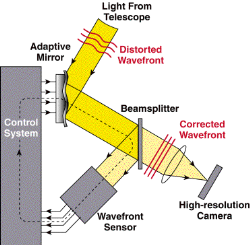Study Bay Coursework Assignment Writing Help
Adaptive Optics
Adaptive optics is a technological development used for optical system performance improvement. It works by reducing the effect of wavefront distortions. Light from a distant celestial object gets distorted as it passes through earth’s atmosphere, thus a telescope located on earth’s surface cannot form accurate images. It would take a telescope placed above Earth’s surface, such as the Hubble Space telescope, to acquire accurate images or a telescope able to measure the effect and attempt to correct it. Instruments using adaptive optics have been created for this exact purpose – to eliminate the incoming distortion in light under the effect of our ever-moving atmosphere. Through adaptive optics, optical systems are able to adapt in order to compensate for the effects imposed by the medium in between an object and its image. This is considered the most revolutionary technical development in the field of Astronomy ever since 1609, when Galileo first used an astronomical telescope.
 A graphical example of this effect is presented below:
A graphical example of this effect is presented below:

Figure 1
When uniform waves of starlight enter Earth’s atmosphere they get distorted due to the variations in temperature in atmospheric cells. This causes the light to travel slightly faster in less dense and warm air, resulting in a non-uniform refraction.
An adaptive optical system works by measuring the distortion of an incoming wave of light and correcting its deformation through deformation of a mirror. These optic systems function at high frequencies of around 1000 Hz, which is too fast to allow deformation of a primary mirror so a secondary mirror is used, along with other optical elements placed in the light path.
The main use of adaptive optical systems is in astronomical telescopes and laser communication systems. It has other uses as well, such as microscopy and retinal imaging systems, but the primary progress has been developed in telescope technology.
To better understand the way adaptive optics work, think of starlight as waves. When these waves reach Earth’s atmosphere, they are entirely flat, but the turbulence causes them to change shape. The telescope receiving a misshaped wave will return a blurry image. If a telescope with adaptive optics is used, the distorted waves would then reflect off of a deformable mirror which is equipped with hundreds of actuators on its back. These actuators detect the shape of the incoming wave and change the mirror’s shape to match that of the wave. The result of this process is an almost entirely accurate image of a flat wave just as it was before entering Earth’s atmosphere. See figure 2.

Figure 2
The system performs wave front sensing and wave front reconstruction, with input from adaptive mirrors.
- Wavefront Sensing (WFS)
WFS provides a signal that is used to estimate the wave front shape. It involves an optical device that is phase- sensitive, along with a highly efficient, low noise detector for photons. The achromatic wave front means that the sensors usually operate within the visible spectrum where the CCD chips and photo diodes have a high quantum efficiency and are virtually noise free.
There are mainly three types of WFS that operate in the broadband spectrum with varying sensitivity and dynamic range. They are the curvature WFS, the Shack-Hartmann WFS, and the Pyramid WFS.
The Shack-Hartmann WFS is based on producing numerous spots corresponding to the local wavefront through the use of lenslets located across the aperture. The average wavefront slope over the subaperture is determined by observing the position of these spots.
The Pyramid WFS is very similar to the Shack-Hartmann WFS when the pyramid is modulated. When the prism is hit on either side by an aberrated ray, it only appears in one pupil. Thus the slope is measured through the distribution of pupil images.
The curvature WFS measures intensity distributions in two different planes, corresponding to the wavefront’s curvature. The most advantageous part of the curvature WFS is the ease of use. In terms of sensitivity at high spatial frequencies, the curvature WFS performs better than the Shack-Hartmann but has low performance when it comes to low special frequency.
- Wavefront Reconstruction
This helps to calculate a suitable correction vector (consisting of voltages sent to the DM from slopes measured at the WFS) to reconstruct the wavefront. In a closed loop, the WFS operates linearly, therfore the reconstruction of the wavefront can be described as:
Dv = s + n
Where n is the measurement noise usually assumed to be Gaussian and uncorrelated,
D is matrix for the interaction between the wavefront sensing and the deformable mirror
These vector matrix calculations are computing intensive, especially because they have to be carried out in microseconds regime. Linear-quadratic-Gaussian (LQG) or Kalman filter can be used to predict the system’s state which would be an improvement of wavefront reconstruction and control. Using such a setup, telescope vibrations can be introduced in the state vector and corrected. The only drawback would be the computational complexity which may be overcome by keeping the use of the scheme to a minimum – only applying it to certain modes.
- Deformable Mirrors (DM)
The atmosphere distorts the incoming light. The induced optical path differences are corrected by the DM. The mirror surface can be deformed by the movement of many small actuators present beneath the optical surface. The “resolution” of this deformation depends on the number of actuators, their separation, operation speed, and response time. There are thousands of actuators present in the DM system for large (<20 m) telescopes.
There are three primary technologies used to produce adaptive optics deformable mirrors: deformable secondary mirrors (DSM), piezo deformable mirrors and micro-optical-electrical-mechanical systems (MOEMS ).
DSM provides adaptive optics correction while keeping up and high transmission and low thermal emissivity. The position of the actuators is handled by an internal control loop. They are normally separated by a few cm and attached to an optical shell.
Piezo DMs have a spacing of actuators of several millimeters. Their response time is over a hundred microseconds. Piezo DMs usually require to be controlled by 8 Davies & Kasper, an adaptive optics system to provide stable wavefront quality because they do not have local position control.
MOEMS use electro-static actuation. They are much smaller than other DMs due to their interactuator spacings of a few hundred microns. Their response time is almost instantaneous, however they require a very large number of actuators, which is currently a technological challenge.
Throughout the development of the telescope which started 400 years ago with a small, manual device that later on evolved into a sophisticated, computerized instrument, two parameters have been vital: the diameter of the telescope and the angular resolution. Since the perfect telescope would have the resolution directly proportional to the inverse of the telescope’s diameter, the ideal would be to convert incoming wavefronts into a perfectly spherical wavefront, only restricted by the diffraction limit.
Adaptive optics were first envisioned by Horace W. Babcock in 1953,[6] but only entered common usage in 1990s, following computer technology development which made it a practical technique. This system was first applied to flood-illumination retinal imaging for the purpose of producing images of single cones in the human eye, in conjunction with scanning laser ophthalmoscopy to produce the first images of retinal microvasculature and associated blood flow and retinal pigment epithelium cells in addition to single cones.
In 1995, Lawrence Livermore installed a laser guide star on the 3-meter Shane telescope at the University of California’s Lick Observatory, which later became the first major astronomical telescope consisting of full adaptive optics.
There has been massive development in adaptive optics in the field of astronomy following these memorable points in history. However, given that in practice there are still too many errors distorting the wavefront, both due to atmosphere and telescope system, even adaptive optics have limitations.
The primary challenges of adaptive optics are: the ability to create an optical system mechanically capable of correcting incoming waves of light and computers’ ability to keep up with the speed required by the atmosphere.
For the first impediment, the telescopes at Mount Wilson Observatory, for example, use two mirrors working together – a tip-tilt mirror which provides the correction of incoming light and a second deformable mirror which aims to shape after the distorted wave of light, making it reflect its actual shape as if outside Earth’s atmosphere.
Both the distorted and undistorted images must be known by the system in order to determine the shape of the deformable mirror. There are several methods that can be used for determining the final shape of a point source at the Earth’s surface. The adaptive optics system at Mount Wilson uses a star near the telescope’s target as the source of the distorted wavefront. That is, it looks at a star as seen through the telescope close to the object under study and determines how it has been distorted from its expected appearance. This technique is advantageous because no extra equipment is needed, the light from the source passes through the entire atmosphere and it is located in proximity to the object studied. The downside is that it requires the object being observed to be close to a relatively bright star. Because the isoplanatic patch for the atmosphere is so small, only a small part of the sky could be close enough to a bright star to be observed.
There have been attempts to overcome this limitation by using lasers to excite sodium atoms producing an artificial star instead of a guide star. The technique involves projecting a laser beam into the sky close to the object of interest. As long as the laser’s light is bright enough, there is no need for a guide star’s light.
The second challenge is caused by the ever-changing distortions. The deformable mirror must modify quickly to keep up with the incoming light. Since this part of the process must be handled through the use of computers, it requires that the systems be fast enough to analyse the incoming wave of light and transmit the appropriate commands to the mirror many times per second. Thus if the turbulence in the atmosphere is increased, the system will have to worker harder in order to achieve accurate results.
Since the first astronomical adaptive optics systems were brought into common use in the early 1990s, a vast number of technical developments have been achieved, numerous ingenious techniques have been created, and it has now come to a point where it is inconceivable to even consider building a large telescope without adaptive optics. Sadly, many of the complex concepts today still exist only on paper or demonstrated on small scale only. Even though many of these innovations have arisen after 2000s, recent years have been mostly dedicated to developing the technology for practical, large scale use of these systems. It seems adaptive optics are fully developed on a theoretical level, but the practical progress is still lacking. It is expected that in the years to come the main areas to be explored and developed will be high-density deformable mirrors with thousands of actuators, high-power sodium lasers and powerful real-time computers with processors exceeding 109 to 1010 operations per second, along with, possibly, fast and low-noise near-IR detectors, since optical detectors with sub-electron read-noise and very high quantum efficiency are already close to perfection.
Many recent astronomical discoveries are directly attributed to the new optical observation developments. With the help of Very Large Telescopes, the role of adaptive optics is very important. With this capability, their huge light-gathering along with the ability to resolve small details, has the potential to bring major progress in ground-based astronomy in the new decade. Further in the future, giant optical telescopes such as E-ELT, will rely on advanced adaptive optics systems for virtually all their observations.
